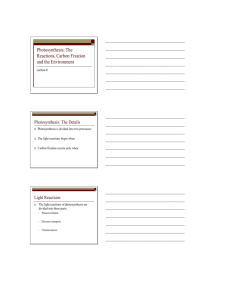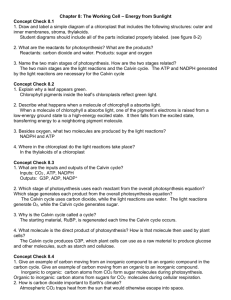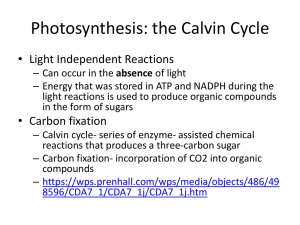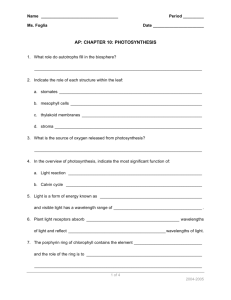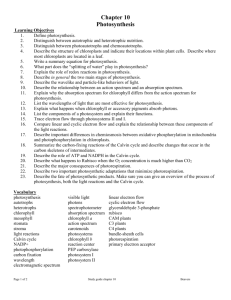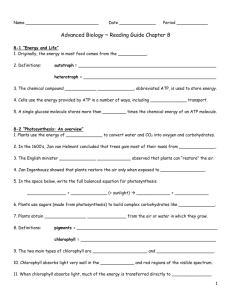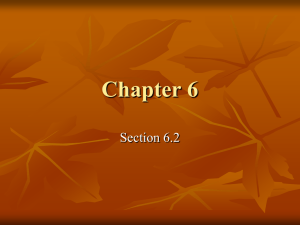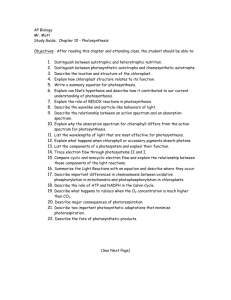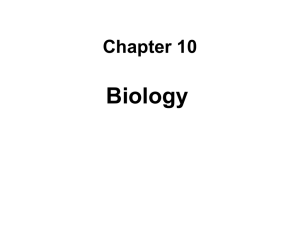Lecture 9 - Photosynthesis 2 TV
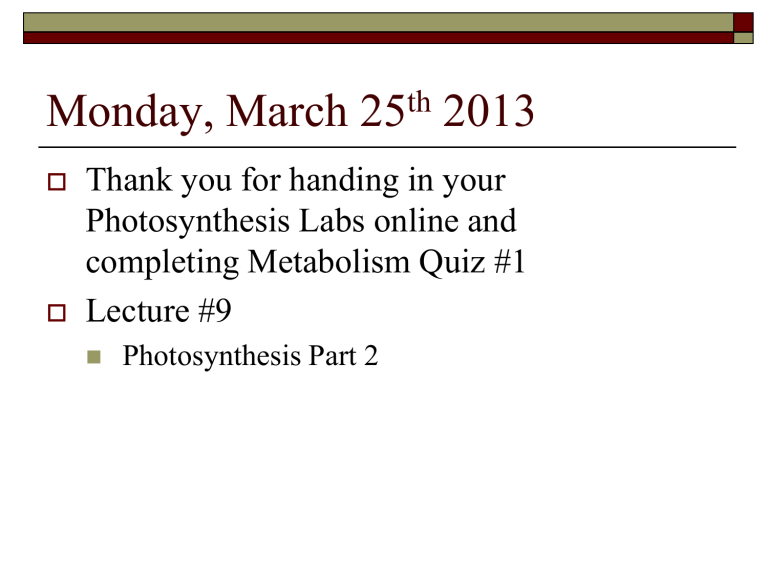
Monday, March 25
th
2013
Thank you for handing in your
Photosynthesis Labs online and completing Metabolism Quiz #1
Lecture #9
Photosynthesis Part 2
Photosynthesis: The Reactions and Alternative Methods of
Carbon Fixation
Lecture 9
Photosynthesis: The Details
Photosynthesis is divided into two processes:
LIGHT REACTIONS and CARBON
FIXATION
The light reactions begin when photons are exposed to a photosynthetic membrane
Carbon fixation occurs only when ATP and
NADPH are formed through the light reactions
Light Reactions
1.
2.
3.
The light reactions of photosynthesis are divided into three parts:
Photoexcitation: photons absorbed by chlorophyll
Electron transport: same process as in cellular respiration
Chemiosmosis: Electrons move through ATPase to change ADP to ATP
Photoexcitation
Chlorophyll is a molecule that will behave like any other molecule
Its electrons are existing at a potential energy level know as its GROUND
STATE
When a photon of light hits a chlorophyll molecule, the electrons will gain energy and move to a higher energy state
(EXCITATION)
Photoexcitation
The excitation of an electron results in an unstable situation
Normally, the electron will return to its ground state and release or lose the energy it has gained as heat or light
This process is known as FLUORESCENCE
Photoexcitation
In molecules of chlorophyll, the excited electron is “captured” by a PRIMARY
ELECTRON ACCEPTOR
This results in a REDOX reaction, where the chlorophyll has lost an electron (OXIDIZED)
The primary electron acceptor gains the electron (REDUCED)
Photosystems (Fig 3, p. 157)
The photons that hit a chloroplast are always absorbed by a group of chlorophyll molecules and accessory pigments called a
PHOTOSYSTEM
Photosystems have an
ANTENNA COMPLEX and a
REACTION CENTRE
The antenna complex transfers the energy of a photon to the reaction centre where it is absorbed by a molecule of chlorophyll a
Photosystems (Fig. 5 & 6 p. 160)
Photosystem I and Photosystem II both occur in a chloroplast
In both photosystems, a chlorophyll a molecule will absorb photons of light
Photosystem I and II are both used to generate
ATP and NADPH molecules
Cyclic and Non-cyclic Electron Flow
In NON-CYCLIC ELECTRON FLOW, electrons flow from chlorophyll molecules in both photosystems to produce ATP and NADPH, but do not return
In CYCLIC ELECTRON FLOW, electrons flow from chlorophyll molecules in photosystem I to produce ATP
The electron passes through a series of acceptors to return to the chlorophyll in photosystem I
The Calvin Cycle (Fig. 9, p. 161)
The CALVIN CYCLE is a cyclic series of reactions that produces carbohydrate molecules
1.
The Calvin Cycle has three phases
Carbon Fixation – CO
2
(RuBP)
bonds to Ribulose 1,5-bisphosphate
2.
3.
Reduction Reactions
Regeneration of RuBP
These reactions are catalyzed by RIBULOSE BISPHOSPHATE
CARBOXYLASE/ OXYGENASE or RUBISCO
Carbon Fixation (C3 Photosynthesis)
In carbon fixation, CO
2 molecules bond with RuBP (5carbon molecule) to form an unstable 6-carbon intermediate
This 6-carbon intermediate is then split into 2 3-carbon intermediates called 3-
PHOSPHOGLYCERATE
(PGA)
These two 3-carbon molecules are the basis of the sugar molecules formed at the end of the Calvin Cycle
The Calvin Cycle of most plants involves these 3-carbon intermediates and is known as
C3 Photosynthesis
Reduction Reactions
1.
The reduction reactions are as follows:
A 3-carbon PGA molecule is phosphorylated by ATP – becomes 1,3bisphosphoglycerate (1,3-
BPG)
2.
3.
NADPH reduces BPG to G3P
Glyceraldehyde 3-phosphate
(G3P) is the final product of the Calvin Cycle – 1 molecule of G3P leaves
This is a description of what happens to one molecule of
PGA…more than one molecule enters this cycle
Reduction Reactions – The Numbers
Three molecules of CO
2
will enter the Calvin
Cycle at once
Each molecule of CO
2
will form 2 PGA molecules (6 total)
Therefore, there are 6 PGA molecules being reduced to G3P…Why?
Regeneration of RuBP
Remember that RuBP is the reactant that drives the
Calvin Cycle (like
Oxaloacetate in the Kreb’s
Cycle)
The remaining 5 G3P molecules that have been formed are used to regenerate RuBP so that the Calvin Cycle can continue
G3P – The Key Intermediate
Plants will generally construct more sugars than they need
G3P is needed to regenerate RuBP to drive the
Calvin Cycle and to produce other carbohydrates a plant may need for metabolic functions
Typically, G3P will be used to make GLUCOSE
(immediate energy), STARCH (storage), SUCROSE
(transport) or CELLULOSE (cell wall construction and repair)
Alternative Mechanisms of Carbon Fixation:
C4 Photosynthesis and CAM Plants
Rubisco is the enzyme that catalyzes the addition of carbon to RuBP (carboxylation)
It can also add an oxygen to RuBP
If oxygen is more plentiful than CO
2
, oxygen will bind more often
PGA will not be produced and carbohydrate production is also reduced
This process is known as PHOTORESPIRATION and it occurs when STOMATA close on hot, sunny days
Alternative Mechanisms of Carbon
Fixation: C4 Photosynthesis (Fig. 2, p. 169)
In C4 plants, the lack of PGA production has been remedied by an enzyme called
PHOSPHENOLPYRUVATE
CARBOXYLASE (PEP carboxylase)
PEP carboxylase fixes CO
2
to a molecule of
PHOSPHENOLPYRUVATE
(PEP – 3-carbon molecule)
This creates a stable 4-carbon molecule that can be used as an intermediate for the calvin cycle
Alternative Mechanisms of Carbon
Fixation: CAM Plants
Plants that store water
(cacti, pineapples – succulents) are members of the Crassulacea family
These plants open their stomata at night to allow
CO
2
in (opposite of most plants)
This action helps to conserve water, but does not allow CO
2
to enter during sunlight hours
Alternative Mechanisms of Carbon
Fixation: CAM Plants
The CO
2
that is taken in is converted into a C4 intermediate that will be used later by the plant
The C4 molecule is actually an organic acid and the process is called crassulacean acid metabolism or CAM
